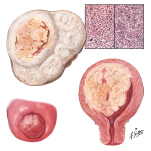Uterine sarcoma is a rare type of uterine cancer which accounts for 10% of all cancers arising from the womb. These tumors typically are derived from the muscle layer of the uterus and its supporting structures. There are 3 main types of uterine sarcomas:
- Carcinosarcoma
- Leiomyosarcoma
- Endometrial stromal sarcoma
Sarcomas of the uterus tend to be slightly more aggressive than the conventional adenocarcinoma of the lining of the uterus. These tumors have a propensity to travel through the blood stream and the lymphatic system to spread to other distant sites. Once identified, these tumors should be removed and treatment should start expeditiously.

RISK FACTORS FOR UTERINE SARCOMA
- Previous radiation to the pelvis. Either for previous treatment of cancer or iatrogenic
- Treatment with tamoxifen for breast cancer. A patient taking this drug should have a pelvic exam every year and report any vaginal bleeding (other than menstrual bleeding) as soon as possible.
SIGNS AND SYMPTOMS
Most common symptom of uterine sarcoma is abnormal bleeding. Here are a list of other associated symptoms which should be immediately evaluated by your gynecologist:
- Bleeding that is not part of menstrual periods.
- Bleeding after menopause.
- A mass in the vagina.
- Pain or a feeling of fullness in the abdomen.
- Frequent urination.
TREATMENT
1. Surgery
Surgery is the most common treatment for uterine sarcoma. This usually involves removal of the uterus and its surrounding structures, including the cervix, ovaries and fallopian tubes, as well as regional lymph nodes in the pelvis.
Even if Dr. Mirhashemi removes all the cancer that can be seen at the time of the surgery, some patients may be offered chemotherapy or radiation therapy after surgery to kill any microscopic cancer cells that are left so as to minimize the risk of recurrence of cancer.
2. Radiation therapy
Radiation therapy is a cancer treatment that uses high-energy x-rays or other types of radiation to kill cancer cells or keep them from growing. There are two types of radiation therapy. External radiation therapy uses a machine outside the body to focus the radiation in the direction of the cancer. Internal radiation therapy or brachytherapy uses a radioactive substance sealed in needles, seeds, wires, or catheters that are placed directly into or near the cancer. The way the radiation therapy is given depends on the type and stage of the cancer being treated.
3. Chemotherapy
Chemotherapy is a cancer treatment that uses medicines to stop the growth of cancer cells, either by killing the cells or by stopping them from dividing. When chemotherapy is taken by mouth or injected into a vein or muscle, the drugs enter the bloodstream and can affect cancer cells throughout the body The way the chemotherapy is given depends on the type and stage of the cancer being treated.
4. Hormone therapy
Hormone therapy is a cancer treatment that removes hormones or blocks their action and stops cancer cells from growing. Hormones are substances produced by glands in the body and circulated in the bloodstream. Some hormones can cause certain cancers to grow. If tests show the cancer cells have places where hormones can attach (receptors), drugs, surgery, or radiation therapy are used to reduce the production of hormones or block them from working.







